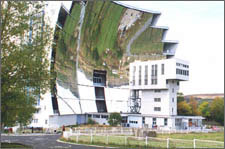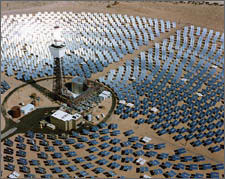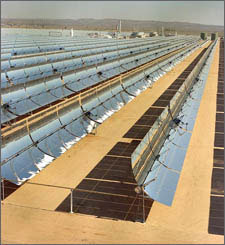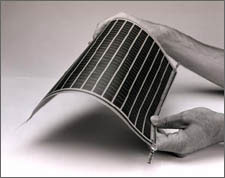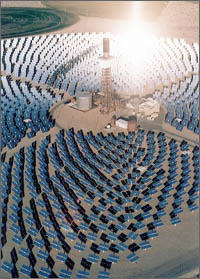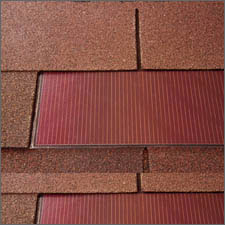7th Century B.C.
A magnifying glass is used to concentrate the sun's rays on a fuel and light a fire for light, warmth, and cooking.
3rd Century B.C.
Greeks and Romans use mirrors to light torches for religious purposes.
2nd Century B.C.
As early as 212 B.C., Greek scientist Archimedes makes use of the reflective properties of bronze shields to focus sunlight and set fire to Rome's wooden ships, which were besieging Syracuse. (Although there is no proof that this actually happened, the Greek navy recreated the experiment in 1973 and successfully set fire to a wooden boat 50 meters away.)
A.D. 20
The Chinese report using mirrors to light torches for religious purposes.
1st to 4th Century
In the first to the fourth centuries, Roman bath houses are built with large, south-facing windows to let in the sun's warmth.
6th Century
Sunrooms on houses and public buildings are so common that the Justinian Code establishes "sun rights" to ensure that a building has access to the sun.
13th Century
In North America, the ancestors of Pueblo people known as Anasazi build south-facing cliff dwellings that capture the warmth of the winter sun.
1767
Swiss scientist Horace de Saussure is credited with building the world's first solar collector, later used by Sir John Herschel to cook food during his South African expedition in the 1830s. See the Solar Cooking Archive for more information on Sassure and His Hot Boxes of the 1700s.
Artist's rendition of de Saussure's solar hot box.
1816
On September 27, 1816, Robert Stirling applies for a patent for his economiser at the Chancery in Edinburgh, Scotland. A minister in the Church of Scotland until the age of 86, Stirling builds heat engines in his home workshop in his spare time! Lord Kelvin uses one of the working models in some of his university classes. This engine is later used in the dish/Stirling system, a solar thermal electric technology that concentrates the sun's thermal energy to produce electric power.
1839
French scientist Edmond Becquerel discovers the photovoltaic effect while experimenting with an electrolytic cell made up of two metal electrodes placed in an electricity-conducting solution; the electricity generation increases when exposed to light.
1860s
French mathematician August Mouchet proposes an idea for solar-powered steam engines. In the next two decades, he and his assistant, Abel Pifre, will construct the first solar-powered engines for a variety of uses. The engines are the predecessors of modern parabolic dish collectors.
1873
Willoughby Smith discovers the photoconductivity of selenium.
1876
William Grylls Adams and Richard Evans Day discover that selenium produces electricity when exposed to light. Although selenium solar cells fail to convert enough sunlight to power electrical equipment, they prove that a solid material can change light into electricity without heat or moving parts.
1880
Samuel P. Langley invents the bolometer, used to measure light from the faintest stars and the sun's heat rays. It consists of a fine wire connected to an electric circuit. When radiation falls on the wire, it becomes slightly warmer, and this increases the electrical resistance of the wire.
1883
American inventor Charles Fritts describes the first solar cells made of selenium wafers.
1887
Heinrich Hertz discovers that ultraviolet light alters the lowest voltage capable of causing a spark to jump between two metal electrodes.
1891
Baltimore inventor Clarence Kemp patents the first commercial solar water heater. For more information on the water heater, see the California Solar Center.
1904
Wilhelm Hallwachs discovers that a combination of copper and cuprous oxide is photosensitive.
1905
Albert Einstein publishes his paper on the photoelectric effect, along with a paper on his theory of relativity.
1908
William J. Bailley of the Carnegie Steel Company invents a solar collector with copper coils and an insulated box, which is roughly the same collector design used today.
1914
The existence of a barrier layer in photovoltaic devices is noted.
1916
Robert Millikan provides experimental proof of the photoelectric effect.
1918
Polish scientist Jan Czochralski develops a way to grow single-crystal silicon.
1921
Albert Einstein wins the Nobel Prize for his theories explaining the photoelectric effect; for details, see his 1904 technical paper on the subject.
1932
Audobert and Stora discover the photovoltaic effect in cadmium sulfide.
1947
Because energy had become scarce during the long Second World War, passive solar buildings in the United States are in demand; Libbey-Owens-Ford Glass Company publishes a book titled, Your Solar House, which profiles 49 of the nation's greatest solar architects.
1953
Dr. Dan Trivich of Wayne State University makes the first theoretical calculations of the efficiencies of various materials of different band-gap widths based on the spectrum of the sun.
1954
Photovoltaic technology is born in the United States when Daryl Chapin, Calvin Fuller, and Gerald Pearson develop the silicon photovoltaic (or PV) cell at Bell Labs — the first solar cell capable of generating enough power from the sun to run everyday electrical equipment. Bell Telephone Laboratories then produces a silicon solar cell with 6% efficiency and later, 11% efficiency. See the California Solar Center for more information.
1955
Western Electric begins to sell commercial licenses for silicon photovoltaic technologies. Early successful products include PV-powered dollar bill changers and devices that decode computer punch cards and tape.
Mid-1950s
Architect Frank Bridgers designs the world's first commercial office building featuring solar water heating and passive design. The solar system has operated continuously since then; the Bridgers-Paxton Building is listed in the National Historic Register as the world's first solar-heated office building.
1956
William Cherry of U.S. Signal Corps Laboratories approaches RCA Labs' Paul Rappaport and Joseph Loferski about developing photovoltaic cells for proposed Earth-orbiting satellites.
1957
Hoffman Electronics achieves 8% efficient photovoltaic cells.
1958
T. Mandelkorn of U.S. Signal Corps Laboratories fabricates n-on-p (negative layer on positive layer) silicon photovoltaic cells, making them more resistant to radiation; this is critically important for cells used in space.
Hoffman Electronics achieves 9% efficient photovoltaic cells.
A small PV array (less than one watt) on the Vanguard I space satellite powers its radios. Later that year, Explorer III, Vanguard II, and Sputnik-3 will be launched with PV-powered systems on board. Silicon solar cells become the most widely accepted energy source for space applications, and remain so today. For more information, see the Smithsonian National Air and Space Museum's information on Vanguard I.
1959
Hoffman Electronics achieves a 10% efficient, commercially available photovoltaic cell. Hoffman also learns to use a grid contact, significantly reducing the series resistance.
On August 7, the Explorer VI satellite is launched with a PV array of 9600 solar cells, each measuring 1 cm x 2 cm. On October 13, Explorer VII is launched.
Hoffman Electronics achieves 14% efficient photovoltaic cells.
Silicon Sensors, Inc., of Dodgeville, Wisconsin, is founded and begins producing selenium and silicon photovoltaic cells.
1962
Bell Telephone Laboratories launches Telstar, the first telecommunications satellite; its initial power is 14 watts.
1963
Sharp Corporation succeeds in producing practical silicon PV modules.
Japan installs a 242-watt photovoltaic array, the world's largest to date, on a lighthouse.
1964
NASA launches the first Nimbus spacecraft—a satellite powered by a 470-watt photovoltaic array. See NASA's Nimbus Program for more information.
1965
Peter Glaser conceives the idea of the satellite solar power station.
1966
NASA launches the first Orbiting Astronomical Observatory powered by a 1-kilowatt photovoltaic array; it provides astronomical data in the ultraviolet and X-ray wavelengths filtered out by Earth's atmosphere.
1969
A "solar furnace" is constructed in Odeillo, France; it features an eight-story parabolic mirror.
Photo of a 'solar furnace' that was constructed in Odeillo, France.
1970s
With help from Exxon Corporation, Dr. Elliot Berman designs a significantly less costly solar cell, bringing the price down from $100 per watt to $20 per watt. Solar cells begin powering navigation warning lights and horns on offshore gas and oil rigs, lighthouses, and railroad crossings. Domestic solar applications are considered good alternatives in remote areas where utility-grid connections are too costly.
1972
French workers install a cadmium sulfide photovoltaic system at a village school in Niger.
The Institute of Energy Conversion is established at the University of Delaware to do research and development on thin-film photovoltaic and solar thermal systems, becoming the world's first laboratory dedicated to PV R&D.
1973
The University of Delaware builds "Solar One," a PV/thermal hybrid system. Roof-integrated arrays feed surplus power through a special meter to the utility during the day; power is purchased from the utility at night. In addition to providing electricity, the arrays are like flat-plate thermal collectors; fans blow warm air from over the array to heat storage bins.
1976
The NASA Lewis Research Center starts installing the first of 83 photovoltaic power systems on every continent except Australia. They provide power for vaccine refrigeration, room lighting, medical clinic lighting, telecommunications, water pumping, grain milling, and classroom television. The project takes place from 1976 to 1985 and then from 1992 to completion in 1995.
David Carlson and Christopher Wronski of RCA Laboratories produce the first amorphous silicon photovoltaic cells, which could be less expensive to manufacture than crystalline silicon devices.
1977
In July, the U.S. Energy Research and Development Administration, a predecessor of the U.S. Department of Energy, launches the Solar Energy Research Institute (today's National Renewable Energy Laboratory), a federal facility dedicated to finding and improving ways to harness and use energy from the sun.
Total photovoltaic manufacturing production exceeds 500 kilowatts; 1 kilowatt is enough power to light about ten 100-watt light bulbs.
1978
NASA's Lewis Research Center installs a 3.5-kilowatt photovoltaic system on the Papago Indian Reservation in southern Arizona—the world's first village PV system. It provides power for water pumping and residential electricity in 15 homes until 1983, when grid power reaches the village. The PV system is then dedicated to pumping water from a community well.
1980
ARCO Solar becomes the first company to produce more than 1 megawatt (a thousand kilowatts) of photovoltaic modules in one year.
At the University of Delaware, the first thin-film solar cell exceeds 10% efficiency; it's made of copper sulfide and cadmium sulfide.
1981
Paul MacCready builds the first solar-powered aircraft — the Solar Challenger — and flies it from France to England across the English Channel. The aircraft has more than 16,000 wing-mounted solar cells producing 3,000 watts of power.
1982
The first megawatt-scale PV power station goes on line in Hisperia, California. The 1-megawatt capacity system, developed by ARCO Solar, has modules on 108 dual-axis trackers.
Australian Hans Tholstrup drives the first solar-powered car — the Quiet Achiever — almost 2,800 miles between Sydney and Perth in 20 days — 10 days faster than the first gasoline-powered car to do so. Tholstrup is the founder of a world-class solar car race, Australia's World Solar Challenge.
In California, the U.S. Department of Energy and an industry consortium begin operating Solar One, a 10-megawatt central-receiver demonstration project. It establishes the feasibility of power-tower systems, a solar-thermal electric or concentrating solar power technology. In 1988, the final year of operation, the system could be dispatched 96% of the time. For more information, see Solar Two Demonstrates Clean Power for the Future.
Photo of the Solar Two, a 10-megawatt central receiver power tower that operated in Daggett, CA.
Solar Two, a 10-megawatt central receiver power tower that operated in Daggett, CA.
Volkswagen of Germany begins testing photovoltaic arrays mounted on the roofs of Dasher station wagons; the arrays generate 160 watts for the ignition system.
The Florida Solar Energy Center's Southeast Residential Experiment Station begins supporting the U.S. Department of Energy's photovoltaics program in the application of systems engineering.
Worldwide, photovoltaic production exceeds 9.3 megawatts.
1983
ARCO Solar dedicates a 6-megawatt photovoltaic substation in central California. The 120-acre, unmanned facility supplies Pacific Gas & Electric Company's utility grid with enough power for up to 2,500 homes.
Solar Design Associates completes a home powered by an integrated, stand-alone, 4-kilowatt photovoltaic system in the Hudson River Valley.
Worldwide, photovoltaic production exceeds 21.3 megawatts, and sales top $250 million.
1984
The Sacramento Municipal Utility District commissions its first 1-megawatt photovoltaic electricity generating facility.
1985
Researchers at the University of South Wales break the 20% efficiency barrier for silicon solar cells.
1986
The world's largest solar thermal facility is commissioned in Kramer Junction, California. The solar field contains rows of mirrors that concentrate the sun's energy onto a system of pipes circulating a heat transfer fluid. The heat transfer fluid is used to produce steam, which powers a conventional turbine to generate electricity.
Photo of one of the largest nine solar power plants built in 1980 in Kramer Junction, California.
This solar power plant in Kramer Junction, California, is the largest of nine built in the 1980s. Oil in the receiver tubes collects the concentrated solar energy as heat and is pumped to the power plant to generate electricity.
ARCO Solar releases the G-4000 — the world's first commercial thin-film module.
1988
Dr. Alvin Marks receives patents for two solar power technologies: Lepcon and Lumeloid. Lepcon consists of glass panels covered with millions of aluminum or copper strips, each less than a thousandth of a millimeter wide. As sunlight hits the metal strips, light energy is transferred to electrons in the metal, which escape at one end in the form of electricity. Lumeloid is similar but substitutes cheaper, film-like sheets of plastic for the glass panels and covers the plastic with conductive polymers.
President George Bush announces that the U.S. Department of Energy's Solar Energy Research Institute has been designated the National Renewable Energy Laboratory.
1992
Researchers at the University of South Florida develop a 15.9% efficient thin-film photovoltaic cell made of cadmium telluride, breaking the 15% barrier for this technology.
Photo of thin-film modules made of amorphous silicon.
Thin-film modules, like this one made of amorphous silicon, can be deposited on a variety of low-cost substrates, such as glass and flexible plastic sheets.
A 7.5-kilowatt prototype dish system that includes an advanced stretched-membrane concentrator begins operating.
1993
Pacific Gas & Electric installs the first grid-supported photovoltaic system in Kerman, California. The 500-kilowatt system is the first "distributed power" PV installation.
Photo of a 500-kilowatt photovoltaic system installed at Pacific Gas and Electric Company. Pacific Gas and Electric Company's installed a 500-kilowatt photovoltaic system at its Kerman substation to reinforce a weak feeder. PG&E found that distributed systems like this have measurable benefits that include increased system reliability and peak-shaving capabilities.
The National Renewable Energy Laboratory (formerly the Solar Energy Research Institute) completes construction of its Solar Energy Research Facility; it will be recognized as the most energy-efficient of all U.S. government buildings in the world.
1994
The first solar dish generator to use a free-piston Stirling engine is hooked up to a utility grid.
The National Renewable Energy Laboratory develops a solar cell made of gallium indium phosphide and gallium arsenide; it's the first one of its kind to exceed 30% conversion efficiency.
1996
The world's most advanced solar-powered airplane, the Icare, flies over Germany. Its wings and tail surfaces are covered by 3,000 super-efficient solar cells, for a total area of 21 square meters.
The U.S. Department of Energy and an industry consortium begin operating Solar Two — an upgrade of the Solar One concentrating solar power tower. Until the project's end in 1999, Solar Two demonstrates how solar energy can be stored efficiently and economically so power is produced even when the sun isn't shining; it also spurs commercial interest in power towers. See Solar Two Demonstrates Clean Power for the Future for more information.
Photo of the Solar Two project in Daggett, California.
The Solar Two project improved the 10-megawatt Solar One central receiver plant in Daggett, California. A field of mirrored heliostats focused sunlight on a 300-foot (91-meter) tower filled with molten salt, which could be heated to 1050 F. The salt was pumped through a generator and the resulting steam powered a conventional, high-efficiency turbine to produce electricity.
1998
On August 6, a remote-controlled, solar-powered aircraft, "Pathfinder," sets an altitude record of 80,000 feet on its 39th consecutive flight in Monrovia, California — higher than any prop-driven aircraft to date.
Subhendu Guha, a scientist noted for pioneering work in amorphous silicon, leads the invention of flexible solar shingles, a roofing material and state-of-the-art technology for converting sunlight to electricity on buildings.
Photo of Photovoltaic shingles mounted directly onto a roof.
Photovoltaic shingles are mounted directly onto a roof, taking the place of asphalt shingles. The PV system is connected to the utility grid through an inverter and produces electricity on the customer's side of the meter.
1999
Construction is completed on 4 Times Square in New York, the tallest skyscraper built in the city in the 1990s. It has more energy-efficient features than any other commercial skyscraper and includes building-integrated photovoltaic (BIPV) panels on the 37th through the 43rd floors on the south- and west-facing facades to produce part of the building's power.
Photo of a 48-story New York City skyscraper, 4 Times Square, that was designed in the 1990s-and features a photovoltaic skin that includes thin-film PV panels.
Times Square's most advanced feature is its photovoltaic "skin," in which thin-film PV panels replace traditional glass cladding material. The PV curtain wall extends from the 37th to the 43rd floor on the south and west walls of the building. The Durst Organization developed the building, incorporating many energy-efficient features. Kiss+Cathcart Architects designed the PV system, along with Fox and Fowle, the base building architects. Energy Photovoltaics of Princeton, New Jersey, developed the custom PV modules.
Spectrolab, Inc., and the National Renewable Energy Laboratory develop a 32.3% efficient solar cell. The high efficiency results from combining three layers of photovoltaic materials into a single cell, which is most efficient and practical in devices with lenses or mirrors to concentrate the sunlight. The concentrator systems are mounted on trackers to keep them pointed toward the sun.
Researchers at the National Renewable Energy Laboratory develop a record-breaking prototype solar cell that measures 18.8% efficient, topping the previous record for thin-film cells by more than 1%. Cumulative installed photovoltaic capacity reaches 1000 megawatts, worldwide.
















